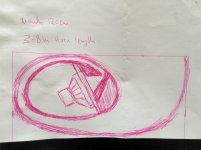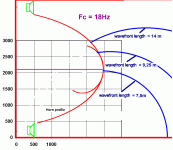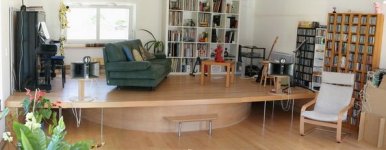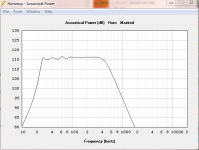Regarding 1:1 compression ratio. In the subjectivists camp I've heard that a cone should always be under compression in a horn or it will sound bad. In the objectivists camp they say that cone size (implying CR) isn't as relevant to horn design as motor strength and the horn. And option C, the throat baffle acts as a phase plug.
Is it fair to ignore option A even when using a type of horn that loads?
FWIW, I learned all aspects of speaker design primarily to 'feed'/'fuel' my main hobby, so I view designing horn, etc., systems same as I did for designing complex hi-perf racing intake, exhaust, suspension systems, i.e. many variables, options that must be chosen to meet the needs of the intended app; ergo it depends on the driver's specs, flare and frequency factor, boundary loading, etc., for the intended app same as the pioneers did.
GM
Thanks GM
So, if one was to aim for 100hz to 800hz, using 515....approx what size mouth and horn length used? I could build quality 5 or 7 sided conical using one inch hardwood.
You're welcome!
The 515 would be a poor choice unless loaded with a matching impedance amp and probably plus some variable DF bass tone control to fine tune itsame as the pioneers did. Keep in mind that compression [driver] loaded horns are under-damped devices that requires a horn to over-damp them enough to sum flat over 'x' BW and since conical is merely a WG, it would require a tiny throat and near impossibly small compression chamber and incredibly long, large horn to overcome its powerful motor over a 1 WL long LF BW without it.
The option then is to limit it to a mid-bass, lower mids BW at least 3*Fs to get a 3:1 CR, but it still has to be 1 WL long, so 3x longer than an expo! and why the pioneers initially chose a 1:2 CR and only used a 1/2 WL [truncated expo] of a portion of the driver's lower mids - up BW enough to blend to the large 300-500 Hz multi-cells: http://www.voiceofthetheatre.com/images/vottcatt1945.10.jpg
GM
Again, it confines a portion of the 515's lower mids - up BW enough to blend [well] to the large 300-500 Hz multi-cells [through the XO BW], which helps with speech intelligibility as well as general music reproduction. Remember, all these systems were designed to get the best practical speech intelligibility over some defined HxW arc at high SPL over long distances whether outdoors or indoors firing through a cinema screen.
GM
GM
Thanks.
My inspiration for exploring this is based on the Sato/WE born. Yes, admittedly this used famous 555 CD with extreme wide BW.
I know the horn produced a realistic/dynamic sound....hence my objectives:
1 moderate room friendly size
2 use modern pro driver to try, as best, to give CD dynamics.
3 use CNC method to ease construction.
4 make replicable for DIYers if interested.
5 cover the 100-500 range as there is little in the way of horns that already do this.
6 no fold in horn to assist HF extension
This is why I was asking about smaller driver like 8 inch.
Many people use Azura 160 or Oris with 6 or 8 inch, but this will only give you approx 250 Hz+
Another idea was john inlow's large bass scroll horn, but this is massive. I've taken the concept to bring it down to approx 100hz.
This drawing shows:
5.4 sq foot mouth
150 inch horn length
Throat adjustable to suit driver. John used 15...,but given reduced size, I could aim for 12.
So, there's some background.
Again, all help appreciated.
Andrew.
My inspiration for exploring this is based on the Sato/WE born. Yes, admittedly this used famous 555 CD with extreme wide BW.
I know the horn produced a realistic/dynamic sound....hence my objectives:
1 moderate room friendly size
2 use modern pro driver to try, as best, to give CD dynamics.
3 use CNC method to ease construction.
4 make replicable for DIYers if interested.
5 cover the 100-500 range as there is little in the way of horns that already do this.
6 no fold in horn to assist HF extension
This is why I was asking about smaller driver like 8 inch.
Many people use Azura 160 or Oris with 6 or 8 inch, but this will only give you approx 250 Hz+
Another idea was john inlow's large bass scroll horn, but this is massive. I've taken the concept to bring it down to approx 100hz.
This drawing shows:
5.4 sq foot mouth
150 inch horn length
Throat adjustable to suit driver. John used 15...,but given reduced size, I could aim for 12.
So, there's some background.
Again, all help appreciated.
Andrew.
Attachments
The 16" driver may make the transition from narrow to wide on its own, but if you wanted to do this under horn control, and that's all you wanted to do then a conical or higher T factor hypex won't demand a full size horn to avoid the group delay issues the way a tractrix might.If conical 'only' a WG, begs the question, why bother?
Thanks.
My inspiration for exploring this is based on the Sato/WE born. Yes, admittedly this used famous 555 CD with extreme wide BW.
You're welcome!
The WE 15 horn is tuned to the mean of 100-5 kHz = ~707 Hz, its Fs/Fc, so ditto the 515, i.e. a true building size < 5 Hz infra-bass horn with a 10:1 CR, so could only handle a watt or two at best down low, but efficiency would be > 108 dB/m, ergo would be a true 'Voice of God' VLF horn able to create the low end of thunder claps. A quad array of [4] driver 1803 multi-cells could fill in the rest up to ~9 kHz and a ~150 dB/m super tweeter horn array would complete the illusion if an accurate recording of one could [can?] be made.
Like the conical horn, scaling it up to 100 Hz will probably result in an impossibly small compression chamber, so we're back to a high Fs driver with a > 500 Hz Fhm in a long horn terminated with a minimum ~96" perimeter mouth if setting hard on a massive floor [2pi space] with ideally a max aspect ratio of ~1:1.273 [wide side coupled to the floor]. Length, throat area, ergo driver Sd, would be a function of its 100 Hz flare and desired flare factor. Not having any design info loaded, you'll have to 'fill in the blanks' with Hornresp or similar.
GM
You're welcome!
The WE 15 horn is tuned to the mean of 100-5 kHz = ~707 Hz, its Fs/Fc, so ditto the 515, i.e. a true building size < 5 Hz infra-bass horn with a 10:1 CR, so could only handle a watt or two at best down low, but efficiency would be > 108 dB/m, ergo would be a true 'Voice of God' VLF horn able to create the low end of thunder claps. A quad array of [4] driver 1803 multi-cells could fill in the rest up to ~9 kHz and a ~150 dB/m super tweeter horn array would complete the illusion if an accurate recording of one could [can?] be made.
Like the conical horn, scaling it up to 100 Hz will probably result in an impossibly small compression chamber, so we're back to a high Fs driver with a > 500 Hz Fhm in a long horn terminated with a minimum ~96" perimeter mouth if setting hard on a massive floor [2pi space] with ideally a max aspect ratio of ~1:1.273 [wide side coupled to the floor]. Length, throat area, ergo driver Sd, would be a function of its 100 Hz flare and desired flare factor. Not having any design info loaded, you'll have to 'fill in the blanks' with Hornresp or similar.
GM
Thanks.
My drawing above has mouth at notional perimeter of 128 inches....though I'd need to reconfigure to get an aspect ratio 'more square.'
With all the variables, looks like Hornresp is now a must.
Cheers
Your mouth as shown could be acting better than just from the floor to the driver height. I'd consider it as good as the height of the cabinet like the LeCleach style horn. In fact vertically it could be as twice the height of the cabinet since you use the floor, and there is a spreadsheet available for this.
In hornresp you have two options. You could either plot the horn as you see it, and apply the default set of half space loading conditions. Alternatively you could model with two drivers for a horn of twice the height along its length as your mouth centreline is along the floor, then build the 'top half' so to speak.
Horizontally it would be as a quasi cylindrical wave horn to some extent.
In hornresp you have two options. You could either plot the horn as you see it, and apply the default set of half space loading conditions. Alternatively you could model with two drivers for a horn of twice the height along its length as your mouth centreline is along the floor, then build the 'top half' so to speak.
Horizontally it would be as a quasi cylindrical wave horn to some extent.
Attachments
Last edited:
Thanks for the feedback, and the previous comments.Your mouth as shown could be acting better than just from the floor to the driver height. I'd consider it as good as the height of the cabinet like the LeCleach style horn. In fact vertically it could be as twice the height of the cabinet since you use the floor, and there is a spreadsheet available for this.
In hornresp you have two options. You could either plot the horn as you see it, and apply the default set of half space loading conditions. Alternatively you could model with two drivers for a horn of twice the height along its length as your mouth centreline is along the floor, then build the 'top half' so to speak.
Horizontally it would be as a quasi cylindrical wave horn to some extent.
I'll work on Hornresp.
BTW, here's the data on the Inlow horn...pretty amazing.
inlowsound.com
Attachments
There is much to like about this horn. As GM states it is worth considering the loading of the horn.
As I see it this initially means looking at the horn expansion near the mouth, and then the expansion from the mouth into the room. And though discontinuities at this point might be discovered and considered to be capable of reflecting back through the mouth, the room will at some frequencies be more than just a loading space/baffle arrangement where room modes due to the 'other' walls have an effect.
This is what I believe GM was stating earlier and I don't see it as something that offers a solution off the top of ones head so to speak.
As I see it this initially means looking at the horn expansion near the mouth, and then the expansion from the mouth into the room. And though discontinuities at this point might be discovered and considered to be capable of reflecting back through the mouth, the room will at some frequencies be more than just a loading space/baffle arrangement where room modes due to the 'other' walls have an effect.
This is what I believe GM was stating earlier and I don't see it as something that offers a solution off the top of ones head so to speak.
Thanks for the feedback, and the previous comments.
I'll work on Hornresp.
BTW, here's the data on the Inlow horn...pretty amazing.
inlowsound.com
That's a horn worth the lumber
Thanks.
My drawing above has mouth at notional perimeter of 128 inches.....
You're welcome!
OK, then the horn will be longer physically, and acoustically if coupled to a sufficient boundary, ergo its output will roll off a little lower and with a little less 'ripple'.
GM
As I see it this initially means looking at the horn expansion near the mouth, and then the expansion from the mouth into the room.
Right, a baffle whether made of some 'solid' material or just air molecules if close coupled to another creates a 2x area mirror image, which if a terminus acoustically increases the expansion out to this larger 'mirror' terminus and why we can increasingly shorten a horn as it moves from 4pi to 8pi spacial loading.
GM
Thanks Allen, GM
The roll off early is not critical, as suitable subs will cover that. Even if I got 150Hz to 600 I'd be delighted....and this is do-able given Inlwo's staggering 20Hz low end...and mine could be 70% of that size.
You're welcome!
Something else you need to consider is at what angle the horn's HF will be coming out at in relation to the mids/HF horn's when done in a spiral as 600 Hz is only ~7.2" in diameter and you want good summation in both planes at some average LP. Note the dashed line on the WE horn: http://www.romythecat.com/Site_Images/WE15A_diagram.jpg
GM
- Status
- This old topic is closed. If you want to reopen this topic, contact a moderator using the "Report Post" button.
- Home
- Loudspeakers
- Multi-Way
- Exotic CNC'd 100Hz-600Hz bass horn - help sim please



